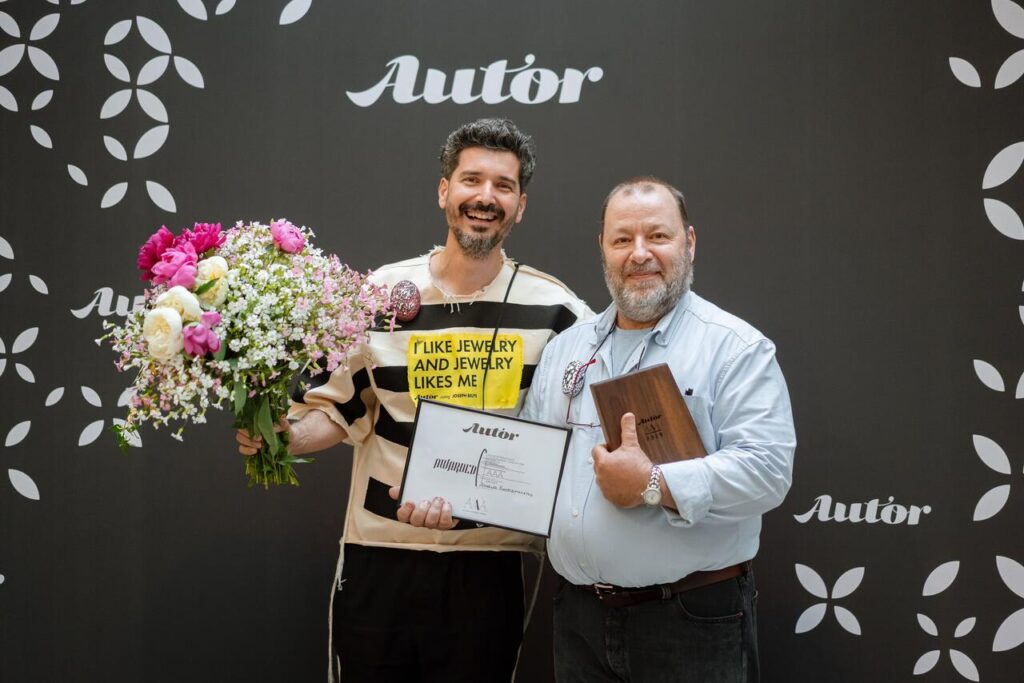Through an original approach, both in concept and technique, the prestigious AUTOR Awesome Award of 2024 was granted to Angelos Konstantakatos. The artist returns for AUTOR 2025 as the Artist Focus, on May 10–11, at Unirea Shopping Center.
Known for pushing the boundaries of contemporary jewelry through experimental techniques and unconventional materials, Angelos merges his background in architecture with a relentless drive for innovation. His artistic journey is deeply rooted in process, curiosity, and a passion for individuality—values that resonate powerfully with AUTOR’s ethos.
In this exclusive interview, Angelos opens up about his new collections, the evolution of his work, and what it means to be back in Bucharest for this special edition of the fair.

Angelos, you were awarded the AUTOR Awesome Award in 2024 and are now returning to Bucharest as this year’s Focus Artist. How has this recognition shaped your artistic journey over the past year?
That recognition felt like being lost in a desert, unsure of direction—when suddenly, someone comes along, gives you a friendly pat on the back, and says, “Keep going. You’re on the right path.” It became a powerful motivator. The award pushed me to become better than I was last year—not to rest, but to evolve.
You mentioned that your two new collections are closely connected to “Filling the Gap” and the earlier “Second Chance.” How do these collections relate to each other, and what shared narrative do they carry?
For me, creating jewelry begins with tinkering, not with a predetermined subject. The theme comes after—it’s a reflection of what the process reveals to me. “Second Chance” was about seeing endings from a new perspective, bringing them back to life. I used mushrooms as the main material—symbols of renewal.
“Filling the Gap” was about completing something left unresolved, often using auxiliary materials from “Second Chance.” My upcoming collection, New Era, continues this path, using familiar forms and sizes but with new design technologies. The second new collection, Diversity and Inclusion, shows that even disparate elements in my work can coexist in harmony—different, yet connected.

You’re bringing a few never-before-seen pieces from your previous collections to Bucharest. Why was this important, and how do they contextualize your new work?
I felt it was important to bring in pieces that help tell the full story—showing where I started and how my work has evolved. Including these previously unseen pieces helps create a clearer, more complete narrative. They’ve never been shown before, but they deepen the understanding of what I’m presenting now.
Your practice often involves unconventional materials like fungi and expanded polystyrene. What draws you to them, and how do you turn them into wearable pieces?
I’m drawn to difficult, unruly materials—ones most artists avoid. Mushrooms, algae, fruit… they’re fascinating. But it’s not the material itself that draws me—it’s the process it demands. I need to invent tools, develop techniques, and figure out how to work with the material. That’s what excites me. I can spend months experimenting before a single piece is finished.

In previous interviews, you’ve said that jewelry should be as unique as the person wearing it. How do you keep that individuality alive in your work?
I believe jewelry is a silent statement. It shouldn’t just “match an outfit”—it should declare: “I’m special, I’m unique. Treat me accordingly.” That’s why I never make the same piece twice. Just like no two people are the same, no two of my creations are, either.
With your background in architecture, how does that influence your jewelry design? Do you see crossovers between the disciplines?

Absolutely. Architecture teaches you to think in three dimensions, to consider both the part and the whole, to solve structural problems, and to design with intention. Whether I’m creating a building or a piece of jewelry, the approach is the same: concept, analysis, design, construction, result. Only the scale changes.
You’ve said that you get bored easily and are always searching for something new. How do you stay creative?
I lose interest when I’ve mastered something—once I understand how it works, I’m ready to move on. There are so many techniques and materials out there, so many unsolved “puzzles.” That curiosity, that experimentation, is my fuel. The more difficult or strange the material, the more driven I am to figure it out. That’s what makes jewelry exciting for me.
What does it mean to you to present your work at AUTOR 2025? What are you looking forward to?
AUTOR is a space where so many different artistic voices converge. Visitors come not just to see work—they come to connect, to discover. You might come to see one artist and leave with a new favorite. It’s a celebration of diversity and creativity. I look forward to meeting people—whether they’re visitors, collectors, or fellow artists—who might stay in my life long after the fair ends.
How do you hope people will interact with your pieces? What kind of reactions are you hoping to evoke?
At AUTOR 2024, I noticed two types of visitors: some passed by my booth without even glancing, while others would freeze five meters away, completely captivated. They’d approach slowly, mesmerized, and want to know everything—the story, the materials, the process. That kind of deep, emotional engagement is what I hope for again this year. I want my jewelry to stop people in their tracks.

What advice would you give to emerging artists interested in contemporary jewelry?
First, look at everything. Not just jewelry—look at sculpture, ceramics, painting, textiles, photography. Attend workshops. Learn techniques, even ones unrelated to jewelry. Feed your mind. Then take time to isolate yourself and reflect. Let everything you’ve absorbed settle inside you. When it becomes too much to hold in—that’s when you start creating. And do it for yourself, not for your teacher, client, or friend. That’s where your voice begins.








